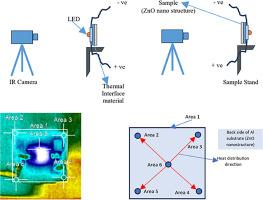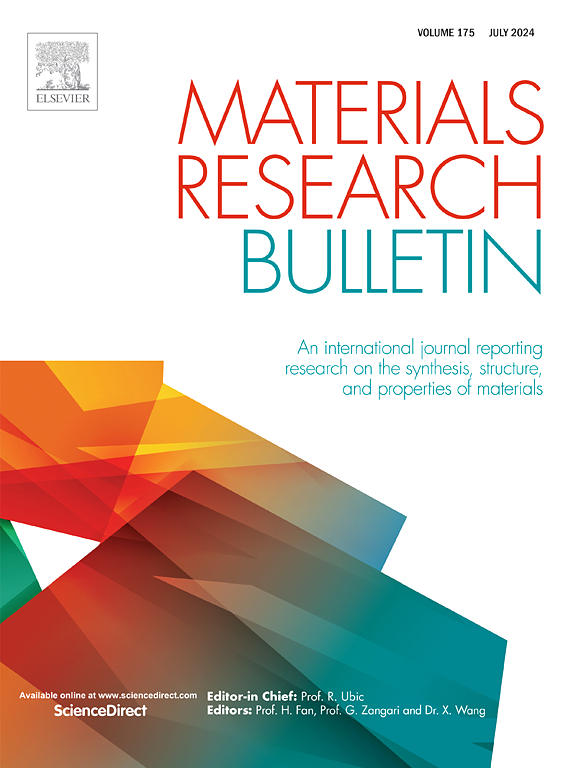ZnO nanostructure as an efficient heat spreader in electronic packaging
IF 5.3
3区 材料科学
Q2 MATERIALS SCIENCE, MULTIDISCIPLINARY
引用次数: 0
Abstract
The purpose of this study is to reduce the material and increase the heat transfer performance for efficient thermal management in electronic devices. Consequently, various types of ZnO nanostructures were synthesized using various zinc acetate dihydrate (ZAD) concentrations (0.001 M, 0.01 M & 0.1 M) and the number of layers (6, 7 & 8), followed by annealing at 350 °C for 1 hr. The various nanostructures such as nano-walls (NWs), nano-leaves (NLs), and nanoflakes (NFs) were observed due to the formation of more aggregation of ZnO nucleation centers at various ZAD concentrations. Surface analysis showed decreased roughness (0.168 to 0.14 μm) with increased concentration and increased roughness (0.14 to 0.32 μm) with an increased number of layers. Among the nanostructures produced, the ZnO NW structure from 0.1 M solution with 7 layers effectively conducted the heat by observing a low LED temperature of 34.48 °C at 0.8 W.
The surface quality was examined with an Atomic Force Microscope (AFM) and showed decreased roughness from 0.168 μm to 0.14 μm with increased concentration and increased roughness from 0.14 μm to 0.32 μm with an increased number of layers. The heat-spreading behavior of each nanostructure was evaluated by an infrared (IR) thermal imaging camera and displayed the surface-dependent heat distribution concerning the Zn concentration, number of layers, and testing current. Among the nanostructures produced, the ZnO NW structure prepared using 0.1 M ZAD solution with 7 layers effectively conducted the heat via through- and in-plane direction, which was proved by observing a low LED temperature of 34.48 °C at 0.8 W. Overall, ZnO nanostructures, especially NWs, offer promising potential for thermal management due to their unique properties at high power density. Consequently, ZnO nanostructures would be considered thermally efficient heat spreaders in electronic devices.

氧化锌纳米结构作为电子封装中的高效散热器
本研究的目的是减少材料,提高传热性能,从而实现电子设备的高效热管理。因此,使用不同浓度(0.001 M、0.01 M 和 0.1 M)和层数(6、7 和 8)的二水醋酸锌(ZAD)合成了各种类型的氧化锌纳米结构,然后在 350 °C 下退火 1 小时。在不同的 ZAD 浓度下,由于 ZnO 成核中心的聚集,观察到了各种纳米结构,如纳米壁 (NW)、纳米叶 (NL) 和纳米片 (NF)。表面分析表明,随着浓度的增加,粗糙度下降(0.168 至 0.14 μm),而随着层数的增加,粗糙度上升(0.14 至 0.32 μm)。用原子力显微镜(AFM)检测了表面质量,结果表明,随着浓度的增加,粗糙度从 0.168 μm 减小到 0.14 μm;随着层数的增加,粗糙度从 0.14 μm 增加到 0.32 μm。红外热像仪评估了每种纳米结构的热扩散行为,并显示了与锌浓度、层数和测试电流有关的表面热分布。在所制备的纳米结构中,使用 0.1 M ZAD 溶液制备的 7 层 ZnO NW 结构能有效地通过面内和面外方向传导热量,在 0.8 W 条件下观察到 34.48 °C 的较低 LED 温度证明了这一点。因此,氧化锌纳米结构可被视为电子设备中的热高效散热器。
本文章由计算机程序翻译,如有差异,请以英文原文为准。
求助全文
约1分钟内获得全文
求助全文
来源期刊

Materials Research Bulletin
工程技术-材料科学:综合
CiteScore
9.80
自引率
5.60%
发文量
372
审稿时长
42 days
期刊介绍:
Materials Research Bulletin is an international journal reporting high-impact research on processing-structure-property relationships in functional materials and nanomaterials with interesting electronic, magnetic, optical, thermal, mechanical or catalytic properties. Papers purely on thermodynamics or theoretical calculations (e.g., density functional theory) do not fall within the scope of the journal unless they also demonstrate a clear link to physical properties. Topics covered include functional materials (e.g., dielectrics, pyroelectrics, piezoelectrics, ferroelectrics, relaxors, thermoelectrics, etc.); electrochemistry and solid-state ionics (e.g., photovoltaics, batteries, sensors, and fuel cells); nanomaterials, graphene, and nanocomposites; luminescence and photocatalysis; crystal-structure and defect-structure analysis; novel electronics; non-crystalline solids; flexible electronics; protein-material interactions; and polymeric ion-exchange membranes.
 求助内容:
求助内容: 应助结果提醒方式:
应助结果提醒方式:


